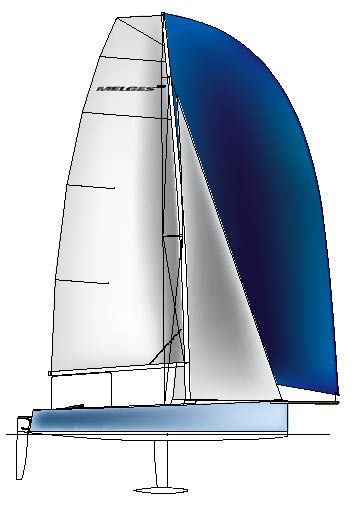Melges 20
2008 July 12
July 2008
Sport Boat
When rating rules were in a state of flux and one-design racing was on the rise we had sailors looking for the thrills of one-design dinghy sailing combined with the stability of a keelboat. It's no surprise that the Melges group, with its extensive background in planing boats, was the first to come up with a boat that bridged this gap-the "sport boat." The Melges 24 introduced a planing hull shape with a huge rig and deep, bulbed keel and no attempt at an interior. The basic design was straight out of the dinghy design book and used a huge asymmetrical chute flown from a retractable pole, such as you would see on a current International 14 dinghy.
That was 800 Melges 24s ago. The 24 was followed by the Melges 30 and the Melges 32. But bigger isn't always better. These boats are true hot rods and the bigger ones can be a handful in a breeze. The latest Melges sport boat is the Melges 20, and this model should be an excellent way to get acquainted with the demands and thrills of sport boat sailing.
The design is once again by Reichel/Pugh, and at this point their credentials for this type of boat are impeccable. The 20 is essentially a dinghy with a fixed fin with a weighted keel bulb. Take that fin and bulb off and replace it with a centerboard or a daggerboard and you would have a dinghy. You'd also need swimming lessons. With 450 pounds in that bulb the 20 should right itself in a knockdown. The D/L is 68.34 using the "all-up weight" of 1,050 pounds and a DWL of 19 feet. The entry is quite fine, the rocker is very flat and there is a bit of chine aft. This is clearly a hull designed for planing. The chine is there but the bottom panel radiuses up to it to soften the interface of bottom and topsides. Note that, in plan view, max beam (L/B 2.86) is carried all the way to the transom. There is no taper at all aft to the deck plan. I asked Andy Burdick of Melges why they did this and his answer was, "Because it looks cool."
Perfect answer.
 The best way to appreciate the rig and power of the 20 is to look at another boat that in its day might have been called a sport boat. I'll pick the Soling Class with a D/L of 109. The Soling carried 233 square feet of sail in mainsail and jib for an SA/D of 21.53. I had a Soling for a while and in its day it was considered a hot rod. The Melges 20 has 62 square feet more sail area and weighs less than half as much for an SA/D of 45.69. This is a huge advantage in the horsepower-per-pound category. The new 20 puts no limit on crew weight and I can imagine with that rig there will be many days when you will want a crew of at least four just to help keep the 20 on its feet. There is no provision for reefing this big square-topped mainsail. With spreaders swept 30 degrees there is no need for a standing backstay. Melges and the designers have worked hard to make the 20 a good ride for "youth and female participation." There are no winches and the deck layout is very simple.
The best way to appreciate the rig and power of the 20 is to look at another boat that in its day might have been called a sport boat. I'll pick the Soling Class with a D/L of 109. The Soling carried 233 square feet of sail in mainsail and jib for an SA/D of 21.53. I had a Soling for a while and in its day it was considered a hot rod. The Melges 20 has 62 square feet more sail area and weighs less than half as much for an SA/D of 45.69. This is a huge advantage in the horsepower-per-pound category. The new 20 puts no limit on crew weight and I can imagine with that rig there will be many days when you will want a crew of at least four just to help keep the 20 on its feet. There is no provision for reefing this big square-topped mainsail. With spreaders swept 30 degrees there is no need for a standing backstay. Melges and the designers have worked hard to make the 20 a good ride for "youth and female participation." There are no winches and the deck layout is very simple.
The Melges 20 is built in China.
Sport Boat

When rating rules were in a state of flux and one-design racing was on the rise we had sailors looking for the thrills of one-design dinghy sailing combined with the stability of a keelboat. It's no surprise that the Melges group, with its extensive background in planing boats, was the first to come up with a boat that bridged this gap-the "sport boat." The Melges 24 introduced a planing hull shape with a huge rig and deep, bulbed keel and no attempt at an interior. The basic design was straight out of the dinghy design book and used a huge asymmetrical chute flown from a retractable pole, such as you would see on a current International 14 dinghy.
That was 800 Melges 24s ago. The 24 was followed by the Melges 30 and the Melges 32. But bigger isn't always better. These boats are true hot rods and the bigger ones can be a handful in a breeze. The latest Melges sport boat is the Melges 20, and this model should be an excellent way to get acquainted with the demands and thrills of sport boat sailing.
The design is once again by Reichel/Pugh, and at this point their credentials for this type of boat are impeccable. The 20 is essentially a dinghy with a fixed fin with a weighted keel bulb. Take that fin and bulb off and replace it with a centerboard or a daggerboard and you would have a dinghy. You'd also need swimming lessons. With 450 pounds in that bulb the 20 should right itself in a knockdown. The D/L is 68.34 using the "all-up weight" of 1,050 pounds and a DWL of 19 feet. The entry is quite fine, the rocker is very flat and there is a bit of chine aft. This is clearly a hull designed for planing. The chine is there but the bottom panel radiuses up to it to soften the interface of bottom and topsides. Note that, in plan view, max beam (L/B 2.86) is carried all the way to the transom. There is no taper at all aft to the deck plan. I asked Andy Burdick of Melges why they did this and his answer was, "Because it looks cool."
Perfect answer.
 The best way to appreciate the rig and power of the 20 is to look at another boat that in its day might have been called a sport boat. I'll pick the Soling Class with a D/L of 109. The Soling carried 233 square feet of sail in mainsail and jib for an SA/D of 21.53. I had a Soling for a while and in its day it was considered a hot rod. The Melges 20 has 62 square feet more sail area and weighs less than half as much for an SA/D of 45.69. This is a huge advantage in the horsepower-per-pound category. The new 20 puts no limit on crew weight and I can imagine with that rig there will be many days when you will want a crew of at least four just to help keep the 20 on its feet. There is no provision for reefing this big square-topped mainsail. With spreaders swept 30 degrees there is no need for a standing backstay. Melges and the designers have worked hard to make the 20 a good ride for "youth and female participation." There are no winches and the deck layout is very simple.
The best way to appreciate the rig and power of the 20 is to look at another boat that in its day might have been called a sport boat. I'll pick the Soling Class with a D/L of 109. The Soling carried 233 square feet of sail in mainsail and jib for an SA/D of 21.53. I had a Soling for a while and in its day it was considered a hot rod. The Melges 20 has 62 square feet more sail area and weighs less than half as much for an SA/D of 45.69. This is a huge advantage in the horsepower-per-pound category. The new 20 puts no limit on crew weight and I can imagine with that rig there will be many days when you will want a crew of at least four just to help keep the 20 on its feet. There is no provision for reefing this big square-topped mainsail. With spreaders swept 30 degrees there is no need for a standing backstay. Melges and the designers have worked hard to make the 20 a good ride for "youth and female participation." There are no winches and the deck layout is very simple. The Melges 20 is built in China.

Comments